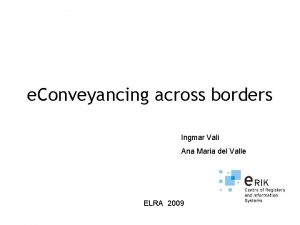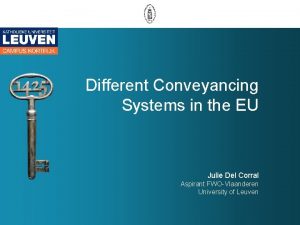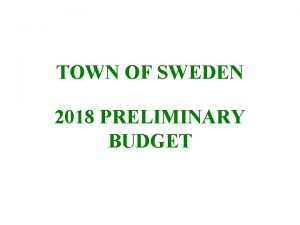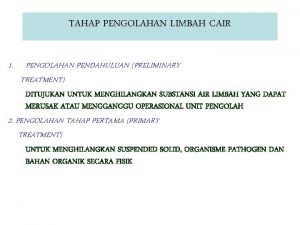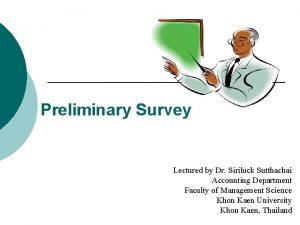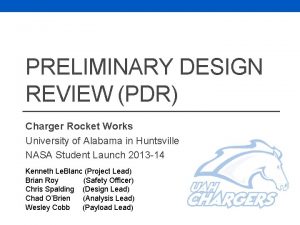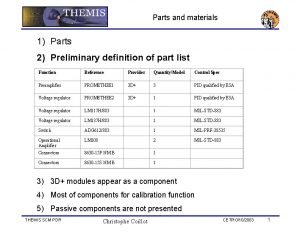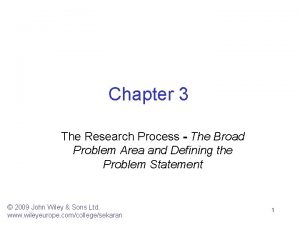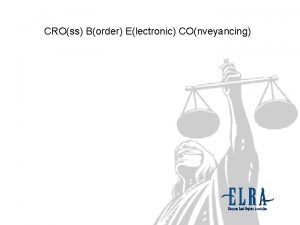Preliminary Findings from the Study on Conveyancing Services













- Slides: 13

Preliminary Findings from the Study on “Conveyancing Services Regulation in Europe” Centre of European Law and Politics, University of Bremen (ZERP): Christoph U. Schmid (Project Co-ordinator) International Real Estate Business School, University of Regensburg: Gabriel S. Lee and Steffen Sebastian Institute for Advanced Studies Vienna (IHS): Marcel Fink and Iain Paterson

Background n Agenda of the European Commission to promote reform and modernisation of restrictive regulation in the professional services area - IHS Vienna Study on regulation in various professional sectors (2003) Commission Report COM 83(2004) and Communication of 5 September 2005 World Bank Report „Doing Business“(2005) outlining wide discrepancies in costs and time to register property transfers

Aims (1) Analysis of one key market and the impact of professional services regulation on it n Conveyancing chosen on account of its high significance for the economy n n Study awarded to ZERP in August 2006, to be concluded at the beginning of 2007

Aims (2) Analyse the relationship between the level of regulation and market outcomes in conveyancing services: 1. Level of regulation : compute a regulatory index on regulation governing: market entry market conduct mandatory intervention consumer protection 2. Market outcomes: price, quality of services, choice for consumers and speed of the transaction

Methodology n n Questionnaire on basic legal and economic aspects of conveyancing, answered by 20 national reporters (SE, FI, DK, DE, FR, UK, Scotland, IE, LU, BE, NL, ES, PT, SI, SL, CZ, HU, PO, A, IT) Web-based survey on market outcomes: price, quality, choice, speed of services Case studies on the reforms in the UK and the Netherlands, on Germany and Sweden Input from professional associations and national competition authorities and questionnaire addressees

Basic legal findings n n Basic orientation: focus on legal professionals, as regulated strongest Four regulatory models: n traditional Latin notary system (ES, PT, FR, BE, LU, DE, A, PO, IT, SL, SI) n deregulated Dutch notary system (NL) n lawyer system (UK, IE, Scotland, HU, CZ) n Nordic licensed agent system (DK, SE, FI)

The Latin Notary System (1) n One neutral professional enjoys exclusive rights and needs to be involved on a mandatory basis n Different degree of involvement: n n n Mandatory for sales contract (PO, DE) or property transfer (NL, ES) Mandatory for the registration only (FR, BE, IT, LU, PT) Mandatory certification of signatures only (SL; SI; A; CZ [also lawyer])

The Latin Notary System (2) n highly regulated: numerus clausus n fixed fees n fixed location n strong limitations on: n • interprofessional cooperation, • business structure, • advertising

The Latin Notary System (3) n Exceptions: n Austria: • no mandatory involvement of any professional, but notary/lawyer have exclusive rights • fees not fixed, but high in practice n n CZ and HU: lawyer or notary Italy: liberalisation of fees in 2006 • consequences not yet clear n Greece: hybrid model: notary + 2 lawyers • most expensive system

The Deregulated Dutch Notary System (1) n Reform of 1999: n numerus clausus abolished • only business plan to be presented by applicant n fees completely liberalized n freedom of establishment enlarged

The Deregulated Dutch Notary System (2) n Consequences: n n Relatively strong competiton among notaries Number of professionals increased by ca. 30% since 1995 Fees for conveyancing decreased whereas fees for other notarial services (e. g. family law, wills) increased Concerns over integrity and quality of advice frequently voiced, but no major problems reported

The Lawyer System n Adversarial model (British Isles): n both parties have their own lawyer vs. „notarial lawyer“ system (HU, CZ, A): one lawyer may act for both parties n n Low degree of regulation: no numerus clausus, liberalised fees (often flat fees) Reform of 1987 admitted licensed conveyancers as competing service providers • Consequence: only small number exists, but solicitors‘ fees decreased

The Scandinavian Licensed Estate Agent System n n Licensed real estate agents provide also legal services Low degree of regulation n Peculiarities n no numerus clausus, negotiable fees few problems due to frequent use of standard contracts DK: buyer usually represented by a lawyer FI: authentication of signatures by notary mandatory Best performance – lowest legal costs of all systems
 Border conveyancing
Border conveyancing Conveyancing systems
Conveyancing systems What is the seattle longitudinal study
What is the seattle longitudinal study Example of conclusion and recommendation in report
Example of conclusion and recommendation in report Preliminary budget
Preliminary budget Preliminary treatment adalah
Preliminary treatment adalah Preliminary survey audit
Preliminary survey audit Preliminary reference earth model
Preliminary reference earth model Preliminary design review example
Preliminary design review example Parts of preliminaries
Parts of preliminaries Mla rough draft example
Mla rough draft example Preliminary interview
Preliminary interview Broad problem area in research examples
Broad problem area in research examples Wilson company prepared the following preliminary budget
Wilson company prepared the following preliminary budget
